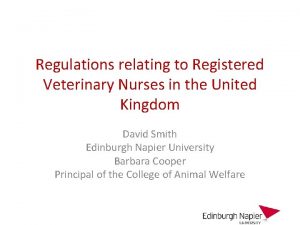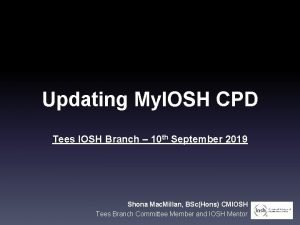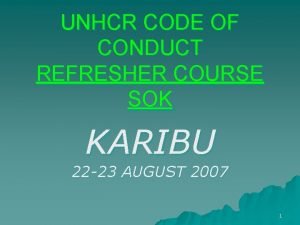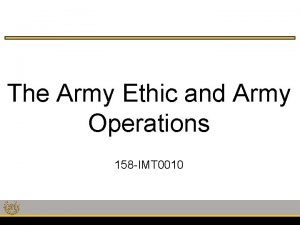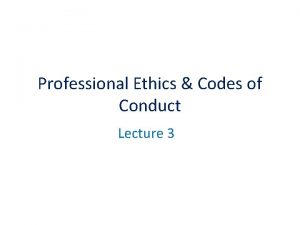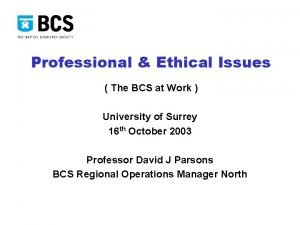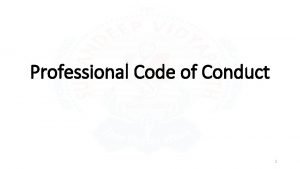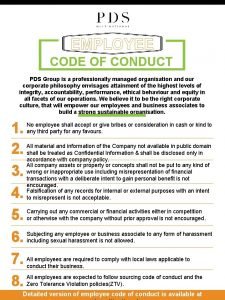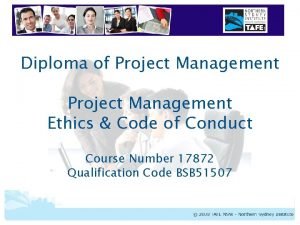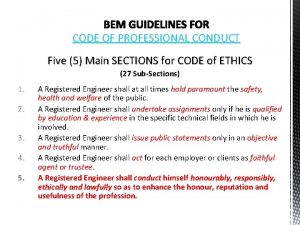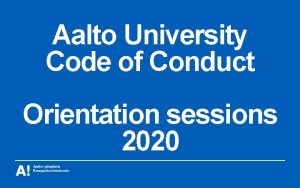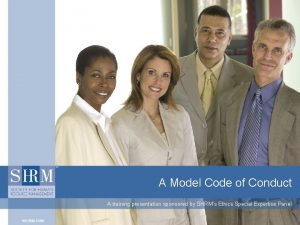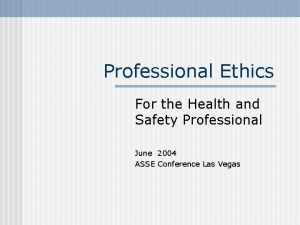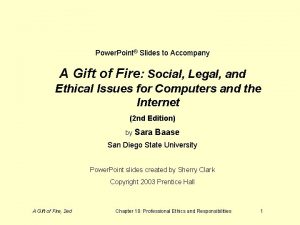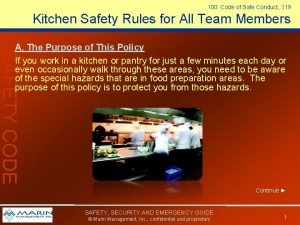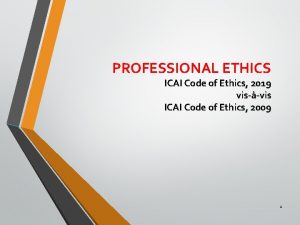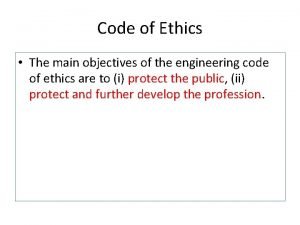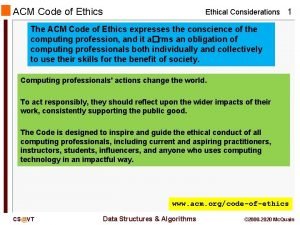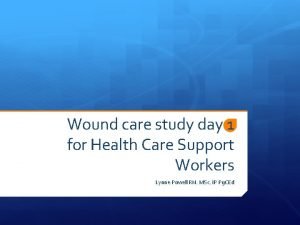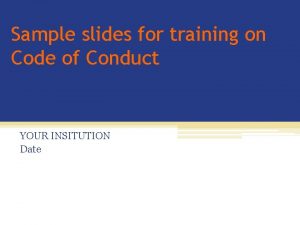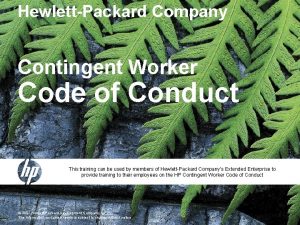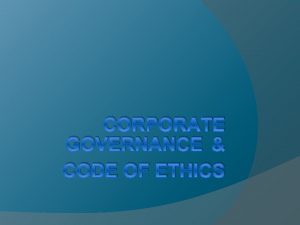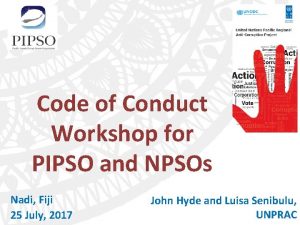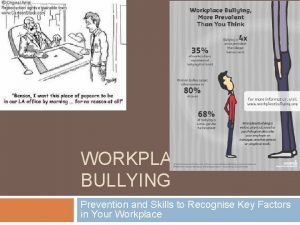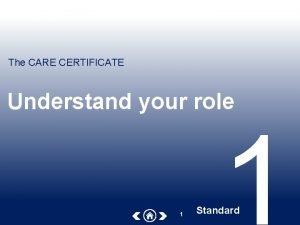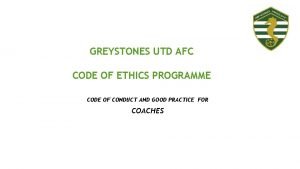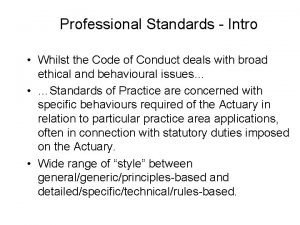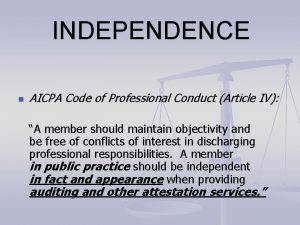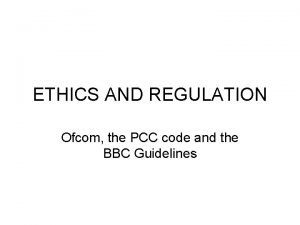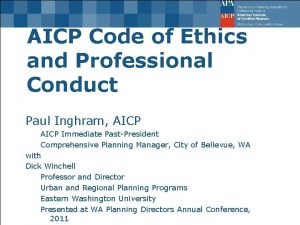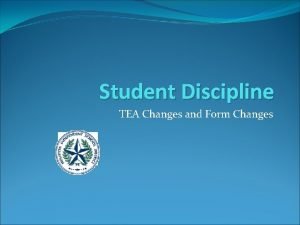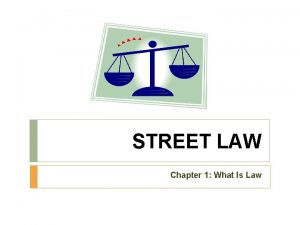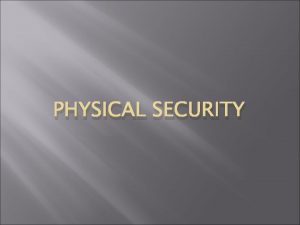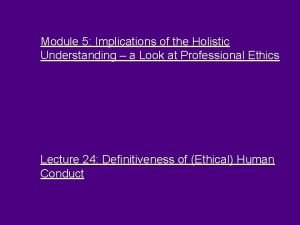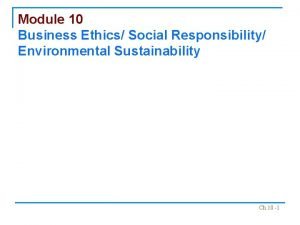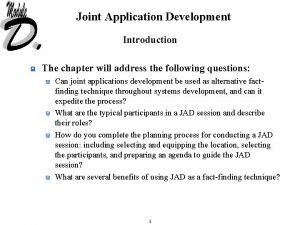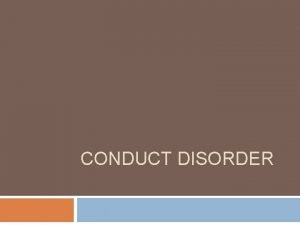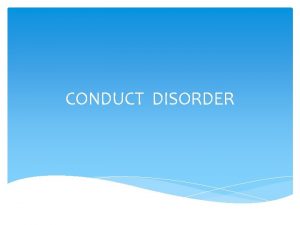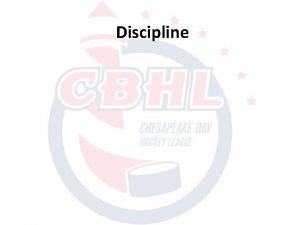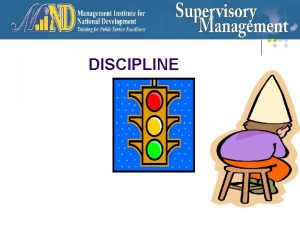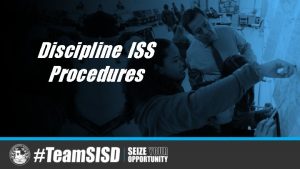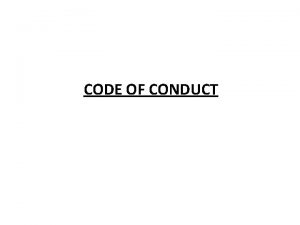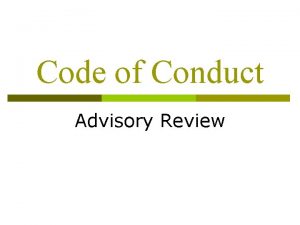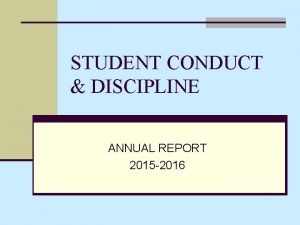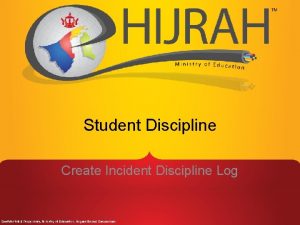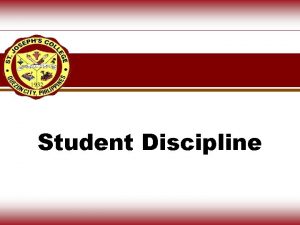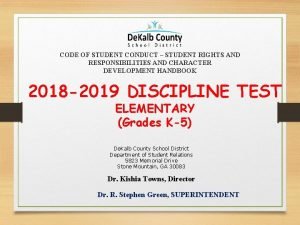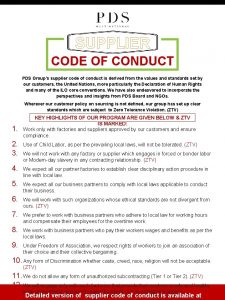Student Discipline Code The Student Code of Conduct
































































































- Slides: 96

Student Discipline Code The Student Code of Conduct is designed to foster student responsibility, respect for others, and to provide for the orderly operation of district schools. It is the policy of the St. Joseph School District to report all crimes occurring on district property to law enforcement including, but not limited to, the crimes the district is required to report in accordance with the law. These policies, regulations, and procedures will apply to all students attending in-district instructional and support programs as well as at school – sponsored events.

Enforcement No person employed by or volunteering on behalf of the St. Joseph School District shall administer, or cause to be administered, corporal punishment upon a student attending district schools. The administration may exclude a student from school because of violation of school rules and procedures, conduct which materially or substantially disrupts the rights of others to an education, or conduct which endangers the student, other students, or the property of the school.

Permissible Types of Discipline Detention In-School Suspension (ISS) Out-of-School Suspension (OSS) Short-term (10 days or less) Long-term (11 -180 days) Expulsion: Can only be done by Board action

Prohibited Types of Discipline Corporal Punishment Confinement in an unattended locked space (unless in an emergency while awaiting arrival of law enforcement) Suspensions determined to be a manifestation of a child’s disability.

Questions? If you have questions or want additional information, you can study SJSD Board policy JG-R 1, JGA, JGB, JGD, JGE, and JGF at http: //esbpublic. sjsd. k 12. mo. us/Reference_Library/ESB_Policies_and_Regulations/Policies//JGR 1. pdf http: //esbpublic. sjsd. k 12. mo. us/Reference_Library/ESB_Policies_and_Regulations/Policies//JGA. pdf http: //esbpublic. sjsd. k 12. mo. us/Reference_Library/ESB_Policies_and_Regulations/Policies//JGB. pdf http: //esbpublic. sjsd. k 12. mo. us/Reference_Library/ESB_Policies_and_Regulations/Policies//JGD. pdf http: //esbpublic. sjsd. k 12. mo. us/Reference_Library/ESB_Policies_and_Regulations/Policies//JGE. pdf http: //esbpublic. sjsd. k 12. mo. us/Reference_Library/ESB_Policies_and_Regulations/Policies//JGF. pdf

Disciplining Students with Disabilities What’s the same and what’s different?

The Same • The district does not believe in a double standard for misbehavior and holds the welfare and safety of all persons in the highest regard. • All students will be referred for law enforcement action when required by law and when their conduct constitutes a crime.

What’s Different? • The district must comply with all state and federal laws governing the discipline of students with disabilities, including the Individuals with Disabilities Education Act (IDEA), Section 504 of the Rehabilitation Act of 1973, applicable regulations, and state and local plans for compliance with the law.

What’s the process look like? Once a student with an Individualized Education Plan (IEP) has been suspended for 10 days or more in a school year, a Manifestation Determination meeting may be required. If the behavior that caused the suspension is NOT a manifestation of the child’s disability, disciplinary consequences may be assigned in the same manner and duration as to a child without a disability, except that the school must provide the services prescribed on the child’s IEP.

What if the behavior is determined to be a manifestation of the disability? • The district must conduct a Functional Behavioral Assessment (FBA), unless one has already been conducted, and implement a behavioral intervention plan (BIP) for the student. • If a BIP is already in place, it must be reviewed and modified to address the behavior(s) that resulted in the suspension(s). • In either case the school district must return the child to the placement from which they were removed unless the parent and district agree to a change of placement.

Are there any exceptions? • Yes. School personnel can remove a student on an IEP to an interim alternative educational setting if any of the following things happen at school, on school premises, at a school function, or at a school sponsored event: 1. Bringing a weapon 2. Knowingly possessing, using, selling, or soliciting the sale of a controlled substance 3. Inflicting serious bodily injury upon another person

Questions? If you have questions or want additional information, you can study SJSD Board policies JGE and JG-R 1 at http: //esbpublic. sjsd. k 12. mo. us/Reference_Librar y/ESB_Policies_and_Regulations/Policies//JGE. pdf http: //esbpublic. sjsd. k 12. mo. us/Reference_Librar y/ESB_Policies_and_Regulations/Policies//JGR 1. pdf

Confidentiality 2017 -18 Training

What does confidentiality mean? • The protection of private, identifying information. • Confidentiality is an inclusive concept that is designed to assure that information will be used responsibly. • It is an integral part of professional codes of ethics that regulate the disclosure of information obtained in the course of professional interactions.

Applicable State and Federal Laws • FERPA: Family Educational Rights and Privacy Act • HIPAA: Health Insurance Portability and Accountability Act of 1996 • IDEA: Individuals with Disability Education Act

FERPA • This law protects the privacy of student education records. • Educational records are defined by FERPA as: Records that directly relate to a student and that are maintained by an educational agency or institution or by a party acting for the agency or institution.

Student/parent rights granted by FERPA • To access educational records kept by the school • To demand educational records be disclosed only with student consent • To amend educational records • To file complaints against the school for disclosing educational records in violation of FERPA

Types of Records • Directory Information • Non-directory Information

Directory Information • May be disclosed by the school without the consent of the student. • Student may restrict the release by submitting a formal request to the school. • Directory information typically includes things like: Name Address Phone # and email address Dates of Attendance (i. e. August 2014 -May 2018) Enrollment Status

Non-directory Information • Any educational record not considered directory is non-directory • Must not be released to any third party without written consent • Faculty and staff can only access this information if they have a legitimate educational reason to do so. • The types of non-directory information that must be closely guarded include: Grades Attendance Health Information Disability Status Discipline Test scores

HIPAA • The Health Insurance Portability and Accountability Act is a 1996 Federal law that restricts access to individuals’ private medical information. • The district has the responsibility of protecting the confidentiality of student health information. • This health information should only be released to employees who have a “need to know”.

ADA • The Americans with Disabilities Act of 1990 is a wideranging civil rights law that is intended to protect against discrimination based on disability. • Disability status must be kept confidential. • Disability status information should only be released to employees who have a “need to know”.

Questions? If you have questions or want additional information, you can study SJSD Board policy JO at http: //esbpublic. sjsd. k 12. mo. us/Ref erence_Library/ESB_Policies_and_R egulations/Policies//JO. pdf

Child Abuse Reporting � As an employee in an educational institution, you are a mandated reporter and therefore required by law to report child abuse. � State statute requires that you report suspected child abuse to the state agency responsible for the protection of children. � The Missouri Child Abuse/Neglect Hotline Unit (CANHU) is operated 24/7/365. It is run by 52 trained and experienced Children's Services workers. The toll-free number for the state of Missouri is: 1 -800 -392 -3738.

Child Abuse Reporting � Failure to promptly report can result in your being arrested and charged with a criminal count of “Neglect of a Child”. � The penalties of such a charge range from misdemeanor to felony. � The threshold to report is “reasonable cause”. If you have reasonable cause: Report � Make sure you let the building principal know.

Child Abuse Reporting � *No supervisor may impede you from making a report � *Employees will not be subject to discipline for reporting. � *The above statements are both true as long as you have Reasonable Cause.

Child Abuse Includes: � Threat of Abandonment � Severe demeaning comments � Beating � Withholding � Lewd or sexual acts between adults and children � Exploitation � Child food or essential medical care of a child pornography viewing

What Not to Do � Elicit detailed information from the child. Your responsibility is to report, not investigate. � Call the child’s parents. It is possible that the parents may be involved or at least have been aware of the abuse. � Make promises. � Allow your emotions to affect the child. � Call the alleged abuser a bad person.

Questions? If you have additional questions about this topic, you can go to https: //www. childsafehouse. org/gethelp/report-abuse. cfm Or study SJSD Board of Education policy JHG at http: //esbpublic. sjsd. k 12. mo. us/Reference_Library /ESB_Policies_and_Regulations/Policies//JHG. pdf �

Identifying Signs of Sexual Abuse �The occurrence of one indicator does not necessarily mean a person has experienced sexual abuse. �Indicators of sexual abuse can vary widely from person to person. �Indicators will often be different based on the age of the child.

Possible Warning Signs in Children � Has nightmares or other sleep problems without an explanation � Seems distracted or distant at odd times � Has a sudden change in eating habits � Refuses to eat � Loses or drastically increases appetite � Has trouble swallowing � Sudden mood swings � Leaves clues likely to provoke a discussion about sexual issues.

Possible Warning Signs in Children (continued) � Develops new or unusual fear of certain people or places � Refuses to talk about a secret shared with an adult or older child � Writes, draws, plays, or dreams of sexual or frightening images � Talks about a new older friend � Suddenly has money, toys, or other gifts without reason � Thinks of self or body as repulsive, dirty, or bad � Exhibits adult-like sexual behaviors, language, and knowledge

Possible Warning Signs in Adolescents (teens) �Self-injury (cutting, burning) �Inadequate personal hygiene �Drug and alcohol abuse �Sexual promiscuity �Running away from home

Possible Warning Signs in Adolescents (teens) �Depression/anxiety �Suicide attempts �Fear of intimacy or closeness �Compulsive eating or dieting

What do I do if I suspect abuse? �If you suspect a child/adolescent has been sexually abused based on the listed indicators or if they actually disclose the abuse: � Seek Help! �Let your building administrator and the building counselor and/or social worker know.

Questions? � If you have questions or want additional information, you can study SJSD Board policies GBH and JHG at http: //esbpublic. sjsd. k 12. mo. us/Reference_Library/ESB_Policies_and_ Regulations/Policies//GBH. pdf http: //esbpublic. sjsd. k 12. mo. us/Reference_Library/ESB_Policies_and_ Regulations/Policies//JHG. pdf You can also access an article by the American Psychological Association about recognizing signs of sexual abuse at https: //www. nsopw. gov/en. US/Education/Recognizing. Sexual. Abuse? As px. Auto. Detect. Cookie. Support=1

Discrimination, Harassment, and Retaliation The St. Joseph School Districtly prohibits discrimination and harassment against employees, students, or others on the basis of race, color, religion, sex, national origin, ancestry, disability, age, genetic information, or any other characteristic protected by law. The St. Joseph School District is an equal opportunity employer.

What is discrimination? • Conferring benefits upon, refusing or denying benefits to, or providing differential treatment to a person or class of persons in violation of law based on race, color, religion, sex, national origin, ancestry, disability, age, genetic information, or any other characteristic protected by law.

What do I do if I feel I am being discriminated against? 1. Report 2. Report 3. Report

To whom should I report? • Dr. Brian Kraus is the Compliance Officer for St. Joseph School District. • He can be contacted at the Human Resources Office at 925 Felix Street, by calling 816 -671 -4000 or emailing brian. kraus@sjsd. k 12. mo. us. • If Dr. Kraus is unavailable, the acting compliance officer is Heather Adams. • Heather can be contacted at the Human Resources Office at 925 Felix Street, by calling 816 -671 -4000 or emailing heather. adams@sjsd. k 12. mo. us.

What Is Harassment? • A form of discrimination that occurs when the school or work environment becomes permeated with intimidation, ridicule, or insult that is sufficiently severe or pervasive enough that it unreasonably alters the employment or educational environment.

Sexual Harassment • Sexual Harassment includes, but is not limited to, unwelcome sexual advances, requests for sexual favors, and other verbal or physical conduct of a sexual nature when: 1. Submission to such conduct is made either explicitly or implicitly a term or condition of an individual’s employment. 2. Submission to or rejection of such conduct is used as the basis for employment decisions affecting such individual, or 3. Such conduct has the effect of unreasonably interfering with an individual’s work performance or creating an intimidating, hostile, or offensive working environment.

What do I do if I feel I am being harassed? 1. Report 2. Report 3. Report

To Whom Should I report? • Dr. Brian Kraus is the Compliance Officer for St. Joseph School District. • He can be contacted at the Human Resources Office at 925 Felix Street, by calling 816 -671 -4000 or emailing brian. kraus@sjsd. k 12. mo. us. • If Dr. Kraus is unavailable, the acting compliance officer is Heather Adams. • Heather can be contacted at the Human Resources Office at 925 Felix Street, by calling 816 -671 -4000 or emailing heather. adams@sjsd. k 12. mo. us.

What is retaliation? Intimidating, threatening, coercing, or discriminating against individuals who: • Make complaints of prohibited discrimination or harassment. • Report prohibited discrimination or harassment. • Participate in an investigation, formal proceeding or informal resolution, concerning prohibited discrimination or harassment.

What do I do if I feel I am being retaliated against? 1. Report 2. Report 3. Report

To Whom Should I report? • Dr. Brian Kraus is the Compliance Officer for St. Joseph School District. • He can be contacted at the Human Resources Office at 925 Felix Street, by calling 816 -671 -4000 or emailing brian. kraus@sjsd. k 12. mo. us. • If Dr. Kraus is unavailable, the acting compliance officer is Heather Adams. • Heather can be contacted at the Human Resources Office at 925 Felix Street, by calling 816 -671 -4000 or emailing heather. adams@sjsd. k 12. mo. us.

Review • SJSD Board Policy prohibits any and all forms of discrimination, harassment, and retaliation. • All occurrences of discrimination, harassment, and retaliation should be reported, whether the victim is you or another employee or a student. • Report to Dr. Brian Kraus in the HR office at 925 Felix Street, 816 -671 -4000 or brian. kraus@sjsd. k 12. mo. us.

Questions? • If you have questions or want additional information, you can study SJSD Board policies AC, AC-R, and ACB at http: //esbpublic. sjsd. k 12. mo. us/Reference_Library/ESB_Poli cies_and_Regulations/Policies//AC. pdf http: //esbpublic. sjsd. k 12. mo. us/Reference_Library/ESB_Poli cies_and_Regulations/Policies//AC-R. pdf http: //esbpublic. sjsd. k 12. mo. us/Reference_Library/ESB_Poli cies_and_Regulations/Policies//ACB. pdf

St. Joseph School District Bloodborne Pathogen Awareness Training

What is a BB Pathogen? Microorganisms that are carried in the blood that can cause disease in humans

Common BB Pathogen Diseases • • • Malaria Brucellosis Syphilis Hepatitis B(HBV) Hepatitis C(HCV) Human Immunodeficiency Virus (HIV)

Potentially Infectious Body Fluids • Skin tissue, cell cultures • Any other body fluid • • • Blood Saliva Vomit Urine Semen or vaginal secretions

Transmission Potential § Contact with another person’s blood or body fluid that may contain blood § Mucous membranes: eyes, mouth, nose § Non-intact skin § Contaminated sharps/needles

Universal Precautions § Use of proper PPE § Treat all blood and body fluids as if they are contaminated § Proper cleanup and decontamination § Disposal of all contaminated material in the proper manner

Personal Protective Equipment (PPE) § Anything that is used to protect a person from exposure § Latex or Nitrile gloves, goggles, CPR mouth barriers, aprons, respirators

PPE Rules to Remember § Always check PPE for defects or tears before using § If PPE becomes torn or defective remove and get new § Remove PPE before leaving a contaminated area § Do not reuse disposable equipment

Decontamination § When cleaning up surfaces use Hepacide Quat® § Do an initial wipe up § Spray and allow it to stand for ten minutes then wipe up § Dispose of all wipes in biohazard containers § PPE should be removed and disposed of in biohazard containers

Hand Washing § Wash hands immediately after removing PPE § Use a soft antibacterial soap § A hand sanitizer can be used, but wash with soap and water as soon as possible.

Hepatitis B Vaccination § Strongly endorsed by medical communities § Offered to all potentially exposed employees § Provided at no cost to employees § Declination form

Questions? If you have questions about this topic or would like additional information, you can view the following video at https: //www. youtube. com/watch? v=1 HVr 43 Yk 8 z 4

§ SJSD prohibits all forms of bullying, hazing, and student intimidation. § Students participating in or encouraging inappropriate conduct will be disciplined, which may include but is not limited to suspension, expulsion, and removal from participation in activities. § District staff who permit, tolerate, or condone any form of bullying or hazing will be disciplined or terminated. § SJSD staff will report incidents of bullying and hazing to the building principal or designee.

§ Intimidation, unwanted aggressive behavior, or harassment that is repetitive or is substantially likely to be repeated and causes a reasonable student to fear for his/his physical safety or property, that substantially interferes with the educational performance, opportunities or benefits of any student without exception or that substantially disrupts the orderly operation of the school.

§ Physical actions, including violence § Gestures § Theft or damage to property § Oral or written taunts including name calling and put- downs § Extortion § Threats of retaliation for reporting the bullying

§ A form of bullying committed by transmission of a communication including, but not limited to, a message, text, sound or image by means of an electronic device, computer, or pager. § Even when cyberbullying does not involve district property, activities or technology resources, the district will impose consequences and discipline if there is sufficient nexus to the educational environment, the behavior materially and substantially disrupts the educational environment, the communication involves a threat as defined by law, or the district is otherwise allowed by law to address the behavior.

§ Any activity, on or off school grounds, that a reasonable person believes would negatively impact the mental or physical health or safety of a student or put the student in a ridiculous, humiliating, stressful or disconcerting position for the purposes of initiation, affiliation, admission, membership, or maintenance of membership in any group, class, organization, club, or athletic team. Hazing can occur even when all students involved are willing participants.

§ Sleep deprivation § Physical confinement § Forced conduct that could result in extreme embarrassment or criminal activity § Physical brutality (whipping, branding, beating, etc. ) § Exposure to the elements § Forced consumption of any food, liquor, drug, or other substance § Forced inhalation or ingestion of tobacco products

If you have questions or want more information, you can study SJSD Board of Education policies JFCF and JFCG at http: //esbpublic. sjsd. k 12. mo. us/Reference_Lib rary/ESB_Policies_and_Regulations/Policies//J FCF. pdf http: //esbpublic. sjsd. k 12. mo. us/Reference_Li brary/ESB_Policies_and_Regulations/Policies// JFCG. pdf

Seclusion, Isolation and Restraint Annual Training 2017 -18

• What Is it? • The confinement of a student alone in an enclosed space from which the student is physically prevented from leaving by locking hardware. Seclusion • When can it be used? • Never, except in an emergency situation while awaiting arrival of law enforcement officers

What is it? • The confinement of a student alone in an enclosed space without locking hardware. Doesn’t include ISS, detention or timeout. Isolation • • When can it be used? Sometimes In an emergency situation When less restrictive measures have not worked AND the school has a plan for how to respond to these situations • If the student has an IEP, 504 OR other parent agreed upon plan

• Chemical • Mechanical • Physical Three Types of Restraint

• What is it? • Drugs or medications to manage behavior (not the student’s regular dose) • When can it be used? • Never Chemical Restraint

• What is it? • A device that the student cannot easily remove that restricts freedom of movement or normal access to part of his/her body. Examples include straps, duct tape, cords or garments etc. • When can it be used? • Sometimes, if specified in a student’s specific behavior plan such as an IEP or 504 • (Exceptions: vehicle safety restraints and those used by law enforcement) Mechanical Restraint

• What is it? • Person to person physical contact that restricts the free movement of all or part of a student’s body. • Doesn’t include briefly holding a student for safety purposes or instruction, intervening in a fight, hand over hand assistance, physical escort, etc. Physical Restraint • • When can it be used? Sometimes In an emergency situation When less restrictive measures have not worked AND the school has a plan for how to respond in these situations • If the student has an IEP, 504 OR other parent agreed upon plan

• Student behavior poses a serious, probable threat of imminent physical harm to self or others or destruction of property. • Can only utilize physical restraint or isolation in an emergency situation. Emergency Situation

Report the situation and details to an immediate supervisor such as: • Building Principal • Director of Special Education • Director of Elementary/Secondary Education What do I do if this occurs?

• • • Be empathetic Clarify messages Respect personal space Be aware of your body position Ignore challenging questions Permit verbal venting when possible Set and enforce reasonable limits Keep your nonverbal cues non-threatening Avoid overreacting Use physical techniques only as a last resort Prevention Techniques

• • • Do not turn your back for any reason Always be at the same eye level Allow extra space between you & the student Stand at an angle not directly facing the student Do not maintain constant eye contact Do not shake finger Do not smile Do not touch Remove individual from peers or remove peers from individual Environmental Management Techniques

• Appear calm – relax your body and face • Limit verbal interaction If you do speak: • Keep tone of voice even and low • Be sure your inflection matches the words – no sarcasm • Keep your comments simple and do not defend or take insults personally • Paraphrase and restate comments in the form of a question De-escalation Techniques

If you have questions or want more information, you can study SJSD Board of Education policy JGGA at http: //esbpublic. sjsd. k 12. mo. us/Reference_Library/ESB_Policies_an d_Regulations/Policies//JGGA. pdf Questions?

EPI Pens When and How Should They Be Used?

Anaphylaxis • A severe allergic reaction that occurs suddenly and can be deadly. • Approximately 1 in 20 kids have a food allergy • Typical symptoms are hives, wheezing, puffy eyes, and itching. • If in doubt, give the shot.

How to Use the EPI Pen • Child should be sitting or lying down • Take the EPI pen out of the case • Pop off the cap • Make a fist • Inject in the outer part of the upper thigh • Push until you hear a click and hold for the amount of time recommended by the manufacturer (10, 5, 3 seconds, etc. ) • Call 911 EVERY TIME after administering the shot

Questions? • If you have questions or want more information about this topic, you can watch the following training video at: • https: //www. accessdata. fda. gov/drugsatfda_docs/label/2 016/019430 s 061 lbl. pdf • or study SJSD Board of Education policy JHCF at http: //esbpublic. sjsd. k 12. mo. us/Reference_Library/ESB_P olicies_and_Regulations/Policies//JHCF. pdf • http: //epinephrineautoinject. com/wpcontent/uploads/2016/11/EAI_Patient. Information-2. pdf

Integrated Pest Management • The SJSD Board of Education recognizes the potential impact of both chemicals and pests on health and the environment and requires that all district property and facilities utilize a system of integrated pest management (IPM) for controlling pests. • For the purposes of this policy, pests include, but are not limited to: weeds, insects, arachnids, rodents, reptiles, birds, and other animals other than those used in classroom instruction.

IPM Components The district will work with representatives from nutrition services, operations, building administration, and nursing to develop procedures for implementation of this policy which will include: • Monitoring the number and type of pests present • Accurately identifying the pests to be controlled • An acceptable pest tolerance level • A list of acceptable pest control tactics ranging from no action to chemical controls. • Methods for educating students, parents and staff about pest prevention.

Chemical Treatments • All chemical treatments will be conducted at a time when buildings are unoccupied, other than the individuals conducting the treatment. • No form of chemical management may be applied on district property unless the application is performed by a licensed individual who has prior approval in accordance with this policy and appropriate procedures.

Questions? If you have questions or want additional information, you can study SJSD Board policy EBAC at http: //esbpublic. sjsd. k 12. mo. us/Reference_L ibrary/ESB_Policies_and_Regulations/Policie s//EBAC. pdf

Suicide Prevention Training �Suicide is a leading cause of death in youth ages 10 -24 in Missouri. �All district employees are required to respond immediately when they have a reasonable suspicion that a student may be at risk of suicide. �All employees are required to notify a member of the building Crisis Response Team and/or the building administrator or designee. �DO NOT LEAVE THE STUDENT ALONE!!!

Who is on the Crisis Response Team ? �Building administrator(s) �Counselor(s) �School nurse(s) �School social worker(s) �School Resource Officer

What if I can’t find someone on the Crisis Response Team? �Notify the student’s parent/guardian or �Call the National Suicide Prevention Lifeline at 800 -273 -8255 or �Call local law enforcement in an emergency situation. �As soon as possible, notify the building administration.

Warning Signs that Require Immediate Attention �Talking or writing about suicide or death �Giving direct verbal cues like “I’m going to end it all. ” �Giving less direct verbal cues like “You will be better off without me. ” �Isolating himself/herself from friends �Expressing the idea that life is meaningless

Warning Signs that Require Immediate Attention (cont. ) �Giving away prized possessions �Sudden and unexplained improvement in mood after being depressed �Neglecting appearance and hygiene �Dropping out of school or social, athletic, and/or community events �Obtaining a weapon or other means for hurting him/herself (prescription meds, etc. )

Risk Factors for Suicide �Family history of suicide �Family history of child mistreatment �Previous suicide attempt �History of mental disorders, particularly depression �History of alcohol and/or substance abuse �Local epidemic of suicide �Significant loss (relational, social, work, or financial) �Easy access to lethal means like guns, pills, etc.

Questions? � If you have questions or want additional information, you can study SJSD Board policy JHDF at http: //esbpublic. sjsd. k 12. mo. us/Reference_Library/ESB_Policies_and_ Regulations/Policies//JHDF. pdf
 Veterinary nurse conduct and discipline rules 2014
Veterinary nurse conduct and discipline rules 2014 My iosh cpd
My iosh cpd Code of conduct unhcr
Code of conduct unhcr Pow code of conduct
Pow code of conduct Consolidation of gains
Consolidation of gains Acm code of ethics and professional conduct
Acm code of ethics and professional conduct Bcs ethics
Bcs ethics Code of conduct professional ethics
Code of conduct professional ethics Core value courage
Core value courage Employee code of conduct
Employee code of conduct Project management code of conduct
Project management code of conduct Article of the code of conduct
Article of the code of conduct Overzicht bem codes
Overzicht bem codes Aalto code of conduct
Aalto code of conduct Code of conduct training ppt
Code of conduct training ppt Asse code of conduct
Asse code of conduct Cips code of ethics and professional conduct
Cips code of ethics and professional conduct Kitchen code of conduct
Kitchen code of conduct Icai code of ethics
Icai code of ethics Astrazeneca code of conduct
Astrazeneca code of conduct Engineering code of conduct
Engineering code of conduct Aicpa code of professional conduct summary
Aicpa code of professional conduct summary Acm code of ethics
Acm code of ethics Transient contact
Transient contact What is code of conduct
What is code of conduct Code of conduct training examples
Code of conduct training examples Hp code of ethics
Hp code of ethics P&g corporate governance
P&g corporate governance Article 3 the teacher and the community explanation
Article 3 the teacher and the community explanation What is code of conduct
What is code of conduct Code of conduct meaning
Code of conduct meaning Understand your role
Understand your role Code of conduct meaning
Code of conduct meaning Utd code of conduct
Utd code of conduct Ipra code of conduct
Ipra code of conduct Iaa code of conduct
Iaa code of conduct Pegi code of conduct
Pegi code of conduct Aicpa rule 101
Aicpa rule 101 Pcc code of conduct
Pcc code of conduct Aicp code of ethics and professional conduct
Aicp code of ethics and professional conduct Chapter 37 discipline chart 2021
Chapter 37 discipline chart 2021 Code commit code build code deploy
Code commit code build code deploy Hình ảnh bộ gõ cơ thể búng tay
Hình ảnh bộ gõ cơ thể búng tay Bổ thể
Bổ thể Tỉ lệ cơ thể trẻ em
Tỉ lệ cơ thể trẻ em Gấu đi như thế nào
Gấu đi như thế nào Tư thế worm breton là gì
Tư thế worm breton là gì Chúa yêu trần thế
Chúa yêu trần thế Môn thể thao bắt đầu bằng chữ đua
Môn thể thao bắt đầu bằng chữ đua Thế nào là hệ số cao nhất
Thế nào là hệ số cao nhất Các châu lục và đại dương trên thế giới
Các châu lục và đại dương trên thế giới Công thức tiính động năng
Công thức tiính động năng Trời xanh đây là của chúng ta thể thơ
Trời xanh đây là của chúng ta thể thơ Cách giải mật thư tọa độ
Cách giải mật thư tọa độ Làm thế nào để 102-1=99
Làm thế nào để 102-1=99 Phản ứng thế ankan
Phản ứng thế ankan Các châu lục và đại dương trên thế giới
Các châu lục và đại dương trên thế giới Thơ thất ngôn tứ tuyệt đường luật
Thơ thất ngôn tứ tuyệt đường luật Quá trình desamine hóa có thể tạo ra
Quá trình desamine hóa có thể tạo ra Một số thể thơ truyền thống
Một số thể thơ truyền thống Cái miệng xinh xinh thế chỉ nói điều hay thôi
Cái miệng xinh xinh thế chỉ nói điều hay thôi Vẽ hình chiếu vuông góc của vật thể sau
Vẽ hình chiếu vuông góc của vật thể sau Thế nào là sự mỏi cơ
Thế nào là sự mỏi cơ đặc điểm cơ thể của người tối cổ
đặc điểm cơ thể của người tối cổ Thứ tự các dấu thăng giáng ở hóa biểu
Thứ tự các dấu thăng giáng ở hóa biểu Vẽ hình chiếu đứng bằng cạnh của vật thể
Vẽ hình chiếu đứng bằng cạnh của vật thể Phối cảnh
Phối cảnh Thẻ vin
Thẻ vin đại từ thay thế
đại từ thay thế điện thế nghỉ
điện thế nghỉ Tư thế ngồi viết
Tư thế ngồi viết Diễn thế sinh thái là
Diễn thế sinh thái là Dot
Dot Thế nào là số nguyên tố
Thế nào là số nguyên tố Tư thế ngồi viết
Tư thế ngồi viết Lời thề hippocrates
Lời thề hippocrates Thiếu nhi thế giới liên hoan
Thiếu nhi thế giới liên hoan ưu thế lai là gì
ưu thế lai là gì Hươu thường đẻ mỗi lứa mấy con
Hươu thường đẻ mỗi lứa mấy con Sự nuôi và dạy con của hươu
Sự nuôi và dạy con của hươu Hệ hô hấp
Hệ hô hấp Từ ngữ thể hiện lòng nhân hậu
Từ ngữ thể hiện lòng nhân hậu Thế nào là mạng điện lắp đặt kiểu nổi
Thế nào là mạng điện lắp đặt kiểu nổi What material does not conduct electricity
What material does not conduct electricity Laws that regulate public conduct
Laws that regulate public conduct Anz risk management
Anz risk management Does water conduct electricity
Does water conduct electricity Security survey inspection sample
Security survey inspection sample Definitiveness of ethical human conduct
Definitiveness of ethical human conduct It is a gift bestowed to influence a recipient’s conduct.
It is a gift bestowed to influence a recipient’s conduct. Structure-conduct-performance
Structure-conduct-performance Market conduct supervision
Market conduct supervision Conduct grades chart
Conduct grades chart Joint application development
Joint application development Job analysis
Job analysis How to conduct yourself in the house of god
How to conduct yourself in the house of god
